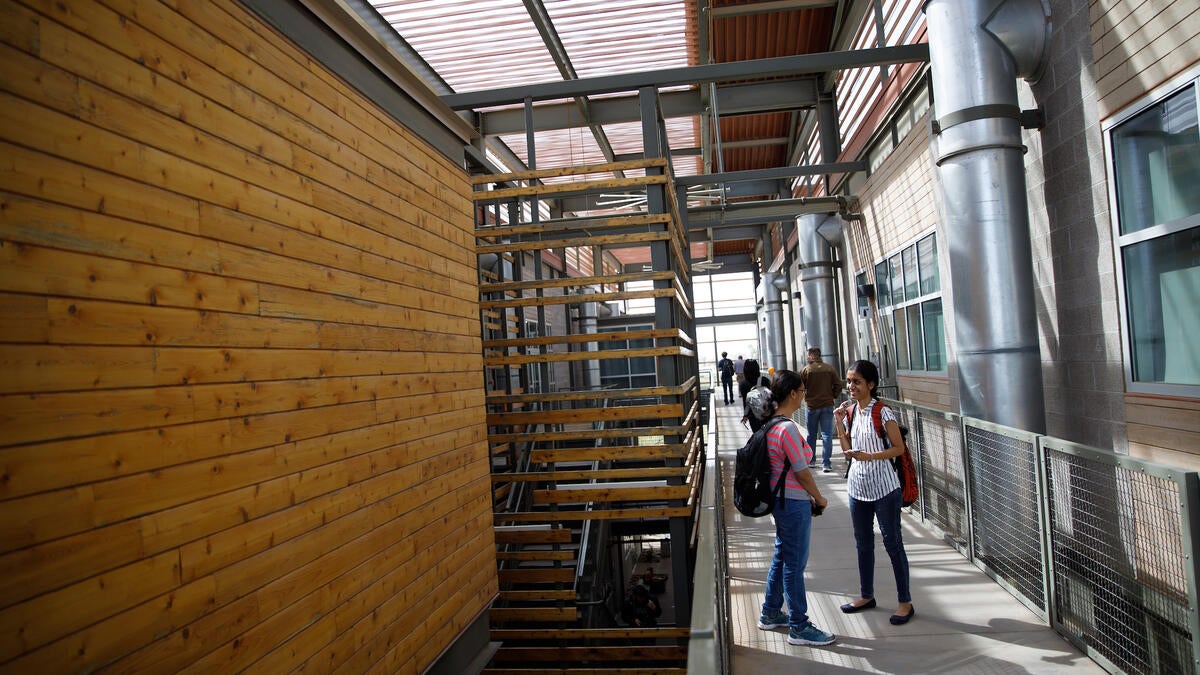What do you do with a degree in interdisciplinary studies?
Everything, as it turns out.
A showcase highlighting interdisciplinary majors’ projects last week also featured a panel discussion with four alumni from the College of Integrative Arts and Sciences at Arizona State University who discussed how the degree has affected their careers.
Students earn the interdisciplinary degree by “doing things other universities won’t let you do,” said ASU faculty member Kevin Ellsworth, who led the team that created the major. With this degree, students pick two subject areas from more than 170 on-campus and 30 online options — ranging from art history to community health to wildlife management — which are combined with a set of core courses.
The four-person panel featured the CEO of a digital marketing and advertising agency, a human resources and operations leader, the CEO of an event and marketing company and the senior manager of an event/meeting planning firm.
“You want to be a Swiss Army knife,” said ASU alumnus Bart Alazio. “You might not know the solution, but you know how to get the solution.”
That’s what an interdisciplinary degree does, according to Alazio, who works producing meeting technology and live events for pharmaceutical and life science industries. He graduated in 2007, studying business and tourism.
People in interdisciplinary studies “are the ones that stick out,” he said. “They’re the stars. I’m always proud to be a part of that. (The College of Integrative Arts and Sciences) does a great job bringing all those professors and mentors together.”
The degree gives a great foundation in developing skills and meeting people.
“There is such a foundational base there that you can live out of the siloed experiences traditional education is based on,” Alazio said.
Elena Carreño graduated with the major in 2019. She is a human resources consultant.
“Taking the info I’ve learned in the program and being able to use it as a framework around what I already was doing and then leveling it up with the new tools I have – this helped me do that a lot better,” said Carreño, whose areas of focus in her degree were organizational leadership and business.
Her one regret? She wishes she had networked more (with kids and a full-time job, she didn’t have the time when she was at ASU).
Brian Colling graduated in 2005, focusing on business and communications. He runs Colling Media, an advertising agency with 30 employees.
“It’s really a way to get you to think differently,” he said about the degree.
Colling said he hires a lot of ASU grads. His go-to interview question? Failure stories.
Steve Levine graduated in 1999. A lifelong entrepeneur, he now runs an event company, Steve Levine Entertainment and PR. His métier ranges from small events to gatherings of tens of thousands of people.
Levine, who focused on communications, said he could have had 10 minors.
“(Interdisciplinary studies) really put it all together,” he said. He needed business skills, broadcasting chops, fashion knowledge and Spanish.
When Levine takes an interdisciplinary studies intern, “you can see that (interdisciplinary studies) really helps,” he said.
He cross-trains all his employees in that vein. During the pandemic, his company went from live events to online events. Now they’re ramping up again.
What would he do differently? “I would stay longer at ASU,” he said. He also wishes he had gotten more involved with campus organizations and clubs.
While at ASU, Levine worked seven nights a week at multiple jobs.
“Maybe I would do more (now),” he said.
Interdisciplinary studies allowed Gabrielle Honda to integrate two different fields for the best of both worlds, she said.
Honda graduated last summer, concentrating on psychology and design, with an emphasis on user experience. She runs a speculative design and arts laboratory.
She initially thought “interdisciplinary studies was kind of like this really cool chose-your-own-adventure major ASU made up. It did not occur to me that it was part of a tradition that existed long before me.”
Top photo: Students talk on the Polytechnic campus. Photo by FJ Gaylor
More Science and technology

Stuck at the airport and we love it #not
Airports don’t bring out the best in people.Ten years ago, Ashwin Rajadesingan was traveling and had that thought. Today, he is an assistant professor at the University of Texas at Austin, but back…

ASU in position to accelerate collaboration between space, semiconductor industries
More than 200 academic, business and government leaders in the space industry converged in Tempe March 19–20 for the third annual Arizona Space Summit, a statewide effort designed to elevate…

A spectacular celestial event: Nova explosion in Northern Crown constellation expected within 18 months
Within the next year to 18 months, stargazers around the world will witness a dazzling celestial event as a “new” star appears in the constellation Corona Borealis, also known as the Northern Crown.…


